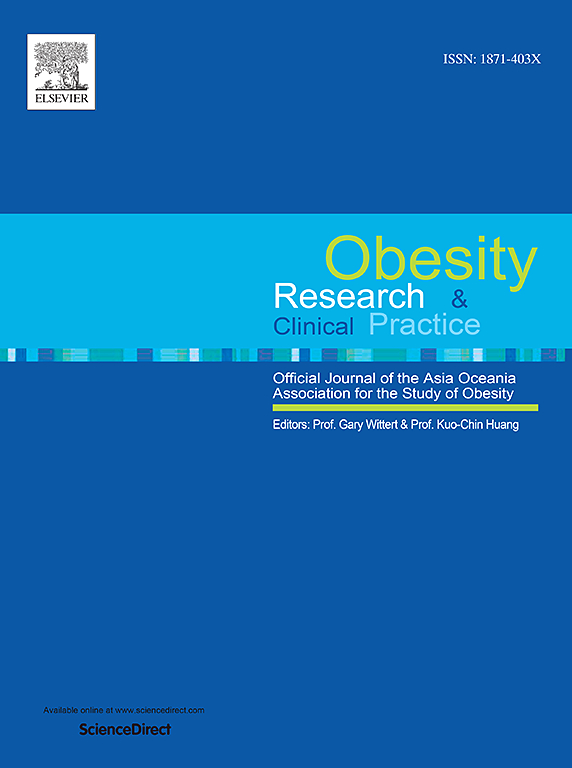Is single anastomosis duodenoileal bypass (SADI) an effective option for conversional surgery following sleeve gastrectomy? A comprehensive review and revised scope of current literature
IF 2.5
4区 医学
Q3 ENDOCRINOLOGY & METABOLISM
引用次数: 0
Abstract
Background
Conversional surgery following sleeve gastrectomy (SG) is required in about 20 % of patients due to suboptimal outcomes. Single anastomosis duodenoileal bypass (SADI) has emerged as an option for such cases, though long-term outcomes remain unclear. This review analyzed available data on SADI as a conversional or second-stage procedure after SG.
Methods
A systematic search across PubMed, Web of Science, and Scopus included studies on adult patients who underwent SADI as a conversional or second-stage surgery following SG, with a minimum of 12 months’ follow-up up to July 2024.
Results
Nineteen studies involving 867 patients examined weight loss, comorbidity resolution, postoperative complications, and nutritional deficiencies. Results showed a total weight loss (TWL) of 24 % in the first year post-revision, with a trend toward weight stabilization or regain over two years. Maximum TWL (27 %) occurred at 24 months, decreasing to 24 % at 60 months. Average follow-up of 27 months showed remission rates for type 2 diabetes, hypertension, and dyslipidemia at 68 %, 53 %, and 37 %, respectively. Short-term morbidity within 30 days was 8 %, including a 5 % rate of anastomotic leaks or fistulas and a 5 % reoperation rate. Overall mortality was 2 %.
Conclusion
In conclusion, SADI shows promise as a safe and effective mid-term conversional surgery after SG with suboptimal results. However, further studies are needed to confirm its long-term safety and effectiveness.
单吻合术十二指肠油膜旁路(SADI)是袖胃切除术后转换手术的有效选择吗?对当前文献的全面回顾和修订范围。
背景:由于预后不佳,约20% %的患者需要在袖胃切除术(SG)后进行转换手术。单吻合十二指肠油膜旁路(SADI)已成为此类病例的选择,但长期结果尚不清楚。本综述分析了SADI作为SG后的转换性或第二阶段手术的现有数据。方法:对PubMed、Web of Science和Scopus进行系统搜索,包括在SG后接受SADI作为转换或二期手术的成年患者的研究,随访时间至少为12个月,至2024年7月。结果:涉及867例患者的19项研究检查了体重减轻、合并症缓解、术后并发症和营养缺乏。结果显示,在修订后的第一年,总体重减轻(TWL)为24% %,两年后体重趋于稳定或恢复。最大TWL发生在24个月(27 %),在60个月下降到24 %。平均随访27个月,2型糖尿病、高血压和血脂异常的缓解率分别为68% %、53% %和37% %。30天内短期发病率为8 %,其中吻合口瘘发生率为5 %,再手术发生率为5 %。总死亡率为2% %。结论:SADI是一种安全有效的SG中期转换手术,但效果不理想。然而,需要进一步的研究来证实其长期的安全性和有效性。
本文章由计算机程序翻译,如有差异,请以英文原文为准。
求助全文
约1分钟内获得全文
求助全文
来源期刊

Obesity research & clinical practice
医学-内分泌学与代谢
CiteScore
7.10
自引率
0.00%
发文量
80
审稿时长
49 days
期刊介绍:
The aim of Obesity Research & Clinical Practice (ORCP) is to publish high quality clinical and basic research relating to the epidemiology, mechanism, complications and treatment of obesity and the complication of obesity. Studies relating to the Asia Oceania region are particularly welcome, given the increasing burden of obesity in Asia Pacific, compounded by specific regional population-based and genetic issues, and the devastating personal and economic consequences. The journal aims to expose health care practitioners, clinical researchers, basic scientists, epidemiologists, and public health officials in the region to all areas of obesity research and practice. In addition to original research the ORCP publishes reviews, patient reports, short communications, and letters to the editor (including comments on published papers). The proceedings and abstracts of the Annual Meeting of the Asia Oceania Association for the Study of Obesity is published as a supplement each year.
 求助内容:
求助内容: 应助结果提醒方式:
应助结果提醒方式:


